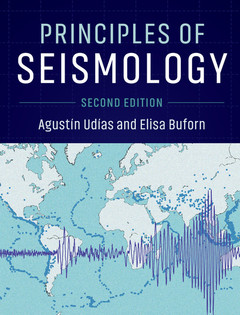Description
Principles of Seismology (2nd Ed., New edition)
Authors: Udías Agustín, Buforn Elisa
This new edition features a completely new chapter on digital seismic data processing, numerous examples and 100 problems.
Language: English
Subject for Principles of Seismology:
Publication date: 12-2017
558 p. · 19.2x25.3 cm · Hardback
558 p. · 19.2x25.3 cm · Hardback
Description
/li>Contents
/li>Biography
/li>
The second edition of Principles of Seismology has been extensively revised and updated to present a modern approach to observation seismology and the theory behind digital seismograms. It includes: a new chapter on Earthquakes, Earth's structure and dynamics; a considerably revised chapter on instrumentation, with new material on processing of modern digital seismograms and a list of website hosting data and seismological software; and 100 end-of-chapter problems. The fundamental physical concepts on which seismic theory is based are explained in full detail with step-by-step development of the mathematical derivations, demonstrating the relationship between motions recorded in digital seismograms and the mechanics of deformable bodies. With chapter introductions and summaries, numerous examples, newly drafted illustrations and new color figures, and an updated bibliography and reference list, this intermediate-level textbook is designed to help students develop the skills to tackle real research problems.
1. Seismology. The science of earthquakes; 2. Earthquakes, Earth's structure and dynamics; 3. Instrumentation and digital data processing; 4. Basic concepts and equations of an elastic medium; 5. Waves in an infinite elastic medium; 6. Reflection and refraction; 7. Body wave propagation in layered media; 8. Ray theory. Media of constant velocity; 9. Ray theory media of variable velocity; 10. Ray theory spherical media; 11. Travel times and the structure of the Earth; 12. Surface waves; 13. Wave dispersion. Phase and group velocities; 14. Free oscillations of the Earth. Theory and observations; 15. Anelasticity and anisotropy; 16. Focal parameters of earthquakes; 17. Basic theory of earthquake mechanism; 18. The seismic moment tensor; 19. Simple models of fracture; 20. Methods of determination of source mechanisms; 21. Seismicity, seismotectonics, seismic risk, and prediction.
Agustín Udías is Emeritus Professor at the Universidad Complutense, Madrid, Spain. He is the author of many papers about seismicity, seismotectonics of the Azores-Gibraltar, and the physics of seismic sources, and has also written several textbooks. Professor Udías has served as Editor-in-Chief of Física de la Tierra and the Journal of Seismology, and as the Vice-President of the European Seismological Commission. He is a member of the Accademia Europeae, the Seismological Society of America, the American Geophysical Union, amongst other societies, and is a Fellow of the Royal Astronomical Society.
Elisa Buforn is a professor of geophysics at the Universidad Complutense, Madrid, Spain, where she teaches courses on geophysics, seismology, physics and numerical methods. Professor Buforn's research focuses on source fracture processes, seismicity and seismotectonics and she is Editor in Chief of Física de la Tierra and on the Editorial Board of the Journal of Seismology. She is member of the Seismological Society of America, American Geophysical Union, Royal Astronomical Society and Real Sociedad Española de Física, amongst other societies.
Elisa Buforn is a professor of geophysics at the Universidad Complutense, Madrid, Spain, where she teaches courses on geophysics, seismology, physics and numerical methods. Professor Buforn's research focuses on source fracture processes, seismicity and seismotectonics and she is Editor in Chief of Física de la Tierra and on the Editorial Board of the Journal of Seismology. She is member of the Seismological Society of America, American Geophysical Union, Royal Astronomical Society and Real Sociedad Española de Física, amongst other societies.
© 2024 LAVOISIER S.A.S.




